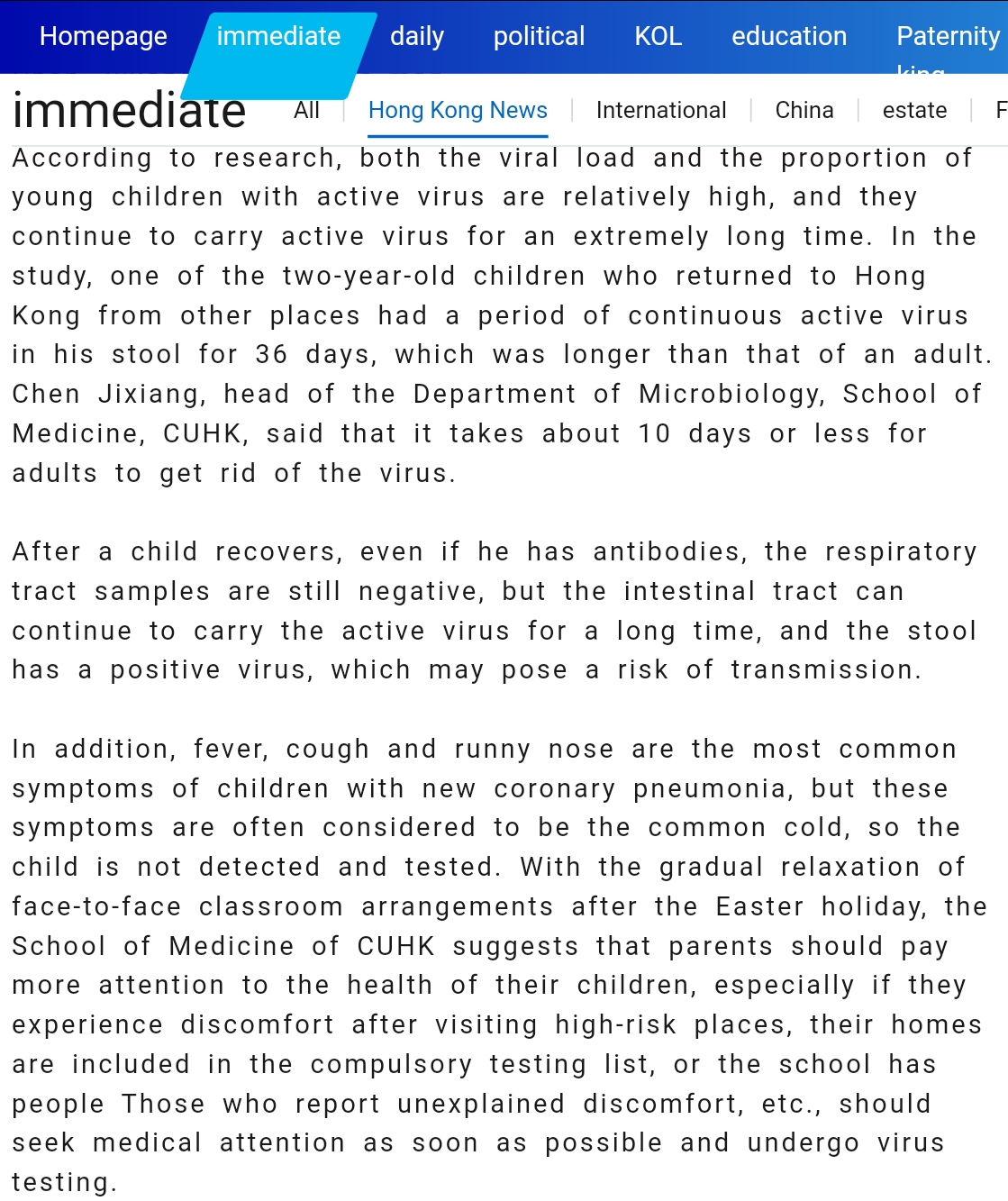It looks like you're using an Ad Blocker.
Please white-list or disable AboveTopSecret.com in your ad-blocking tool.
Thank you.
Some features of ATS will be disabled while you continue to use an ad-blocker.
share:
I don't know about anyone else, but I am now. . . .
A lethal weapon.
A lethal weapon.
originally posted by: Nothin
a reply to: tamusan
That link only displays in Chinese for me. Looked around for a language switch, and didn't find how to view that site in English.
Here is the question was looking for an answer for :
did they test the genome of the samples, to confirm that it is Sars-COV-2™ ?
Went to get an anal swab the other day : the attendant was brought to tears by the magnificence of my arse, and begged me to let her take a selfie with it.
Here I screen capped it. Hope that helps



edit on 6-4-2021 by Bigburgh because: (no reason given)
a reply to: 1947boomer
Gee, thanks for the fact check on humor Zucc.. You can have your wet blanket back.
Gee, thanks for the fact check on humor Zucc.. You can have your wet blanket back.
originally posted by: DBCowboy
I don't know about anyone else, but I am now. . . .
A lethal weapon.
To be fair and clear, we knew back last year that china said the virus was detected in fecal matter as well as other bodily fluids like semen.
You all should be ashamed to talk about audible gastric events.😈
Commence bomb raid sirens!!!
A guide for the big boom boom.
On sub..
March 19th 2020~ Things are not the same after a year, but the vid was entertaining.
edit on 6-4-2021 by Bigburgh because: (no reason given)
"Fecal airborne transmission is real."
Yep. Explosive diarrhea!
Yep. Explosive diarrhea!
edit on 6-4-2021 by Kromlech because: (no reason given)
originally posted by: bigfatfurrytexan
a reply to: tamusan
"could" is only used here because "can't" would be factually incorrect.
Im sorry....but the risk of fecal to airborn contamination would have to be so small as to be irrelevant.
But it does remind me of my initial argument against masks: how come a mask works, but my jeans and drawers can't keep the fart smell in?
I remember you asking that mind-bender last year. Now we know that nothing is an effective mitigator, except living in a bubble attached to 14 in-line air purification units.
a reply to: bigfatfurrytexan
Erm. Boyle's Law? Lotta pressure, or at least in this household.
how come a mask works, but my jeans and drawers can't keep the fart smell in?
Erm. Boyle's Law? Lotta pressure, or at least in this household.
a reply to: Bigburgh
Thanks Pensfanman.
A real shame that they can't tell the difference between Sars-COV-2 and the common cold though, apparently...
Sitting in the lab, testing all of those stool samples, all day long : sure sounds like a crappy job...
Why haven't they invented 'smart' turlets, that measure everything about one's rejected materials ?
Thanks Pensfanman.
A real shame that they can't tell the difference between Sars-COV-2 and the common cold though, apparently...
Sitting in the lab, testing all of those stool samples, all day long : sure sounds like a crappy job...
Why haven't they invented 'smart' turlets, that measure everything about one's rejected materials ?
originally posted by: Kromlech
"Fecal airborne transmission is real."
Tell a radical liberal how at some point in his/her life, he/she will inhale molecules of something that has passed through Donald Trump. Just the thought makes them want to stop breathing, lol.
The world's gone crazy. I don't have anything constructive to add to the discussion, so I'll throw in a couple of bad fart limericks:
From your rear, urgent rumblings have started
Clench-ed buttocks, no more. They have parted!
Noxious gas fills the room;
At your desk, you sense doom.
Some kid yells from behind, "Sir, he's farted!"
Though the party is only just starting,
Our eyes are now visibly smarting.
And the source of the smell,
As those here know full well,
Is your father. He never stops farting.
Worst saved for last:
There once was a man from Rangoon
Whose farts could be heard to the moon
When least you'd expect 'em
They'd burst from his rectum
With the force of a raging typhoon!
From your rear, urgent rumblings have started
Clench-ed buttocks, no more. They have parted!
Noxious gas fills the room;
At your desk, you sense doom.
Some kid yells from behind, "Sir, he's farted!"
Though the party is only just starting,
Our eyes are now visibly smarting.
And the source of the smell,
As those here know full well,
Is your father. He never stops farting.
Worst saved for last:
There once was a man from Rangoon
Whose farts could be heard to the moon
When least you'd expect 'em
They'd burst from his rectum
With the force of a raging typhoon!
edit on 6-4-2021 by ColeYounger because: (no reason given)
Fecal airborne transmission is real
I remember a thread way back called "Stargates are real"
Related?
Thinking back.. wayyy back.
The Hantavirus. Fecal matter from mice/rats can become micro particulates (dust) and inhaled. That was one of the concerns, so I'm wondering if they are considering this as a way to spread Corona virus with human feces. Given some places like Los Angeles or San Francisco where homeless go in public...
www.cdc.gov...
Edit: The Hantavirus has come a long way. It was thought only to be in Deer Mice in the southwest just some 3 decades ago.
The Hantavirus. Fecal matter from mice/rats can become micro particulates (dust) and inhaled. That was one of the concerns, so I'm wondering if they are considering this as a way to spread Corona virus with human feces. Given some places like Los Angeles or San Francisco where homeless go in public...
www.cdc.gov...
How People Become Infected with Hantaviruses
In the United States, deer mice (along with cotton rats and rice rats in the southeastern states and the white-footed mouse in the Northeast) are reservoirs of the hantaviruses. The rodents shed the virus in their urine, droppings, and saliva. The virus is mainly transmitted to people when they breathe in air contaminated with the virus.
When fresh rodent urine, droppings, or nesting materials are stirred up, tiny droplets containing the virus get into the air. This process is known as “airborne transmission“.
There are several other ways rodents may spread hantavirus to people:
If a rodent with the virus bites someone, the virus may be spread to that person, but this type of transmission is rare.Scientists believe that people may be able to get the virus if they touch something that has been contaminated with rodent urine, droppings, or saliva, and then touch their nose or mouth.Scientists also suspect people can become sick if they eat food contaminated by urine, droppings, or saliva from an infected rodent.
The hantaviruses that cause human illness in the United States cannot be transmitted from one person to another. For example, you cannot get these viruses from touching or kissing a person who has HPS or from a health care worker who has treated someone with the disease.
In Chile and Argentina, rare cases of person-to-person transmission have occurred among close contacts of a person who was ill with a type of hantavirus called Andes virus.
Edit: The Hantavirus has come a long way. It was thought only to be in Deer Mice in the southwest just some 3 decades ago.
edit on 7-4-2021 by
Bigburgh because: (no reason given)
new topics
-
President-elect TRUMP Picks MATT GAETZ for his ATTORNEY GENERAL - High Level PANIC Ensues.
2024 Elections: 3 hours ago -
Mike Tyson returns 11-15-24
World Sports: 8 hours ago -
HHS Spent Hundreds of Millions of Dollars on DEI Initiatives Under Biden, Watchdog Finds
US Political Madness: 9 hours ago -
Breaking: FBI Agents Raid Polymarket CEO After Betting Site Predicts Trump Win
General Conspiracies: 9 hours ago -
The Guardian quits Elon Musk's X social media platform
Mainstream News: 10 hours ago
top topics
-
Breaking: FBI Agents Raid Polymarket CEO After Betting Site Predicts Trump Win
General Conspiracies: 9 hours ago, 18 flags -
The Guardian quits Elon Musk's X social media platform
Mainstream News: 10 hours ago, 16 flags -
US warship Edsall Lost after Pearl Harbor Attack Found 80 Years Later ... by Accident
Mainstream News: 13 hours ago, 14 flags -
Thune selected as Senate Republican Leader
US Political Madness: 12 hours ago, 13 flags -
HHS Spent Hundreds of Millions of Dollars on DEI Initiatives Under Biden, Watchdog Finds
US Political Madness: 9 hours ago, 11 flags -
President-elect TRUMP Picks MATT GAETZ for his ATTORNEY GENERAL - High Level PANIC Ensues.
2024 Elections: 3 hours ago, 7 flags -
Band of Brothers 2001 Classic
Television: 12 hours ago, 7 flags -
WATCH LIVE: US Congress hearing on UFOs, unidentified anomalous phenomena
Aliens and UFOs: 15 hours ago, 7 flags -
Worlds Behind You…
Short Stories: 15 hours ago, 4 flags -
Mike Tyson returns 11-15-24
World Sports: 8 hours ago, 3 flags
active topics
-
President-elect TRUMP Picks MATT GAETZ for his ATTORNEY GENERAL - High Level PANIC Ensues.
2024 Elections • 31 • : WeMustCare -
Judge’s Dismissal of Classified Document Case Against Trump Explained
Other Current Events • 19 • : WeMustCare -
Mike Tyson returns 11-15-24
World Sports • 12 • : Flyingclaydisk -
Thune selected as Senate Republican Leader
US Political Madness • 69 • : yuppa -
Post A Funny (T&C Friendly) Pic Part IV: The LOL awakens!
General Chit Chat • 7769 • : MRTrismegistus -
Breaking: FBI Agents Raid Polymarket CEO After Betting Site Predicts Trump Win
General Conspiracies • 18 • : burntheships -
WATCH LIVE: US Congress hearing on UFOs, unidentified anomalous phenomena
Aliens and UFOs • 33 • : WeMustCare -
-@TH3WH17ERABB17- -Q- ---TIME TO SHOW THE WORLD--- -Part- --44--
Dissecting Disinformation • 3258 • : 777Vader -
Fired FEMA Employee Says It Was Not ‘Isolated’ Incident: ‘Colossal Event Of Avoidance’
US Political Madness • 43 • : 777Vader -
On Nov. 5th 2024 - AMERICANS Prevented the Complete Destruction of America from Within.
2024 Elections • 153 • : WeMustCare
